Chris Baty's Blog, page 190
April 22, 2014
"As long as I’m in confessional mode, here’s another thing that makes first-drafting..."
Here’s what I do: I outline as much as I can, with the knowledge that outlines are essentially acts of great and foolish optimism, road maps that will get rewritten along the way.”
- Ransom Riggs, on facing the blank page.
April 21, 2014
Ask An Author: What gets you out of writer's block?
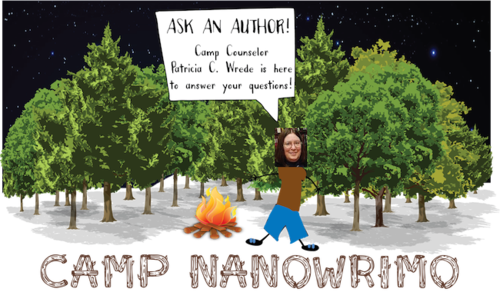
Each week, a new author will serve as your Camp Counselor, answering your writing questions. Patricia C. Wrede, our third counselor, is the much-loved author of the Enchanted Forest Chronicles, and has just published a book for aspiring authors called Wrede on Writing:
What gets you out of a writer’s block? — Anonymous
It depends on what sort of writer’s block you mean. There is real writer’s block, which I define as the actual inability to write so much as a grocery list or email; in my experience, this is usually tied to some non-writing thing like depression, and probably requires therapy. Then there’s what most people mean by “writer’s block,” which is “I am not making progress on my novel.”
This kind of writer’s block happens for one of several reasons:
I just don’t feel like writing today.
I don’t know what happens next.
I know what happens, but it’s something I don’t want to write.
I didn’t think things through, and am either just about to do something hideously wrong or have just done something hideously wrong, and my backbrain refuses to go on until I fix it.
In the case of 1 and 3, what I do is write anyway. It is no fun, but there is no job anywhere that is 100% fun, 24/7.
In the case of 2 and 4, saying “just write” will not work, because something is off; what is required is thinking. If I don’t know what happens next, it’s a matter of thinking about all the various things that could happen next until I get to one I like. This is not casual thinking; it is hard work thinking.
In the case of 4, I won’t be able to progress until I figure out what the problem is and fix it. Ninety-nine percent of the time, for me, the problem is that I made somebody act out of character in order to keep the plot moving; the fix is to have them act in character and then either figure out a way to make my original plot happen anyway, or else figure out where the new action will take the story (which usually involves making up a new plot from there on.)
Next week’s final Camp Counselor will be Michael David Lukas, author of historical novel The Oracle of Stamboul .
April 18, 2014
Ask An Author: "How do you come up with good character names that aren't boring, but aren't ridiculous at the same time?"
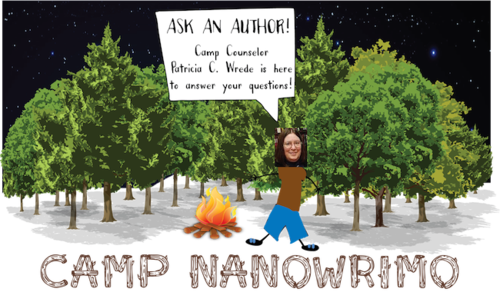
Each week, a new author will serve as your Camp Counselor, answering your writing questions. Patricia C. Wrede, our third counselor, is the much-loved author of the Enchanted Forest Chronicles, and has just published a book for aspiring authors called Wrede on Writing:
How do you come up with good character names that aren’t boring, but aren’t ridiculous at the same time? — infinitycharacters
There are tons of name-your-baby web sites that provide first names (often sortable by country-of-origin), and an equal number of genealogy sites that will provide last names. Google “[name] [first/last name] origin.” If you are writing a present-day, real-world story, this is often all you need.
Historical or alternate-history settings require a little more research, as “favorite” names tend to vary a lot from century to century; for these, check character lists for fiction written in that century, or make yourself a list of actual famous people born at that time and place. This will give you a list of first and last names that you can recombine, and perhaps an indication of the sorts of names not on the list that you can use. You can also check the origins and development of modern names—Mark, as a first name, was Marcus or Markos in the Roman Empire.
If you are inventing your own world, it is a good idea to study some of the above sources to get a feel for how names change over time and cultures. (John, Giovanni, Ioannes, Hans, and Juan are all cited as variations of the same name, for instance.) Then decide if your imaginary cultures have language bases that are similar to real-life countries, whether you want to have echoes of those countries in your imaginary world, and how strong you want the echoes to be.
If you want echoes, use real but obscure names from those countries, or start with a real name and change a letter or two. Or you can break down lists of actual names into syllables and recombine them. There are also online naming programs that you can give a set of rules (like “no double letters” or “w is a vowel” or “all names are two syllables plus –ich or –ora”) that will generate a screen full of names from which you can choose the ones that look and sound right to you.
Make sure any imaginary names are pronounceable, and try not to give two characters in the same book names that are too similar (some recommend not having any first names that begin with the same letter).
Next week’s final Camp Counselor will be Michael David Lukas, author of historical novel The Oracle of Stamboul.
April 17, 2014
Writer Fuel: Of Cheese Sandwiches, Scraps, and Writing Well Enough

Every writer needs a little writer fuel, whether it’s fueling your body, or your mind. Every week, staffers at Camp NaNoWriMo HQ will be telling you about the food and the music that inspires them. Today, our office captain, Shelby Gibbs, shares why “good enough” can be perfect right now:
In my second year of college, I hit several walls. The most startling of these were the sudden ruts of what to eat and, yes, what to write. My peanut butter and banana sandwiches lacked their normal salty-sweet satisfaction; my words had become decidedly lackluster. And me? I was at a loss. Cue a lot of empty take-out boxes, blank pages, and a barely begun John Dunne essay due on Friday.
It was also around this time I discovered an apt, if misinterpreted, song called “Leftovers” by a British artist named Johnny Flynn. He croons:
I’ve been drooling at some mangy scraps of bread/
And these hungry voices make a lot of noise inside my head/
Show me the way to the rubbish dump or the bins at closing time/
I’d walk a mile just to catch a smile from a fish without its brine.
Yes, Flynn is rejoicing the casual nature of his current love life, but all I heard was someone reveling in the present lot they were dealt, even if smelly and rubbish-laden. At that particular time, my writing wasn’t up to my personal snuff. (And when you’re reading Dunne, is it ever?) The enthusiastic desire to appreciate the mundane in “Leftovers” kept me from wallowing in defeat. There was nothing to do other than toast up some stale bread, slap on a slice of American “cheese”, and write stunted sentences fit for my makeshift meals.
I wrote poorly and often until it didn’t feel poor anymore. It was only recently, when the brilliant Paige Knorr talked about overcoming that moment when your taste and expectations don’t match up with your current writing ability on her Writing Marathon live stream, that I realized what was at play in 2009:
One should meet one’s writing where it’s at.
It may never feel perfect in the moment, especially when you’re beginning the ascent towards a writing breakthrough. But that doesn’t make it worthless. For me, there are two certainties about my experience: I never would have written anything good without first writing those “mangy scraps”, nor would I be able to discern the difference.
I hope that if you come upon similar struggles, you can embrace the “good enough” nutritional value of a less-than-perfect meal and getting your point across in the raggedy sentences that come before your prose matures into poetry. As for me, in the midst of another creative impasse and attempts to avoid writing starvation, I’m back to relishing all my leftovers: backwards sentence structures and comforting cheese sandwiches alike.
Trust me. The sandwiches are still delicious.
— Shelby
Photo by Flickr user Lars Plougmann.
April 16, 2014
Ask An Author: "How do you write a convincing villain?"
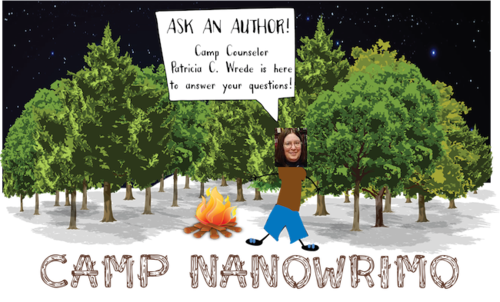
Each week, a new author will serve as your Camp Counselor, answering your writing questions. Patricia C. Wrede, our third counselor, is the much-loved author of the Enchanted Forest Chronicles, and has just published a book for aspiring authors called Wrede on Writing :
How do you write a convincing villain? — Anonymous
The same way you write any character convincingly—by making their dialogue, actions, reactions, and motivations realistic and convincing. The writer has to understand the villain just as thoroughly as he/she understands the main characters. If the writer doesn’t believe that any reasonable, rational person would do whatever evil thing the villain is doing, the villain will most likely come off as a cardboard evil stereotype, or else as insane.
This works for some books, but in many cases, you have to start by asking “Why would a reasonable, rational person kick puppies?” (or whatever it is), and work until you figure out a believable reason.
The next step is getting more of that into the story. This is often harder to do with villains than with other characters, because the villain usually spends less time “on stage” than your main characters. If it’s a multiple-viewpoint book and you can include the villain as a viewpoint character without spoiling a mystery or lessening suspense, that’s one possibility.
In books where the villain can’t be a viewpoint character, you have to keep the villain’s ideas and motivations in mind during any scene the villain appears in (it can help to write the scene from the villain’s viewpoint first, and then rewrite it from the actual viewpoint character’s, though this is more work than some folks like to do).
You also have to keep an eye out for opportunities to reveal to your heroes what the villain’s motives are. One of the most effective things, if you can swing it, is to have the hero make a discovery at some point that makes him seriously wonder if the villain is right, so that the hero has to consider the villain’s actions carefully and almost (but not quite) switch sides. This, too, is not suitable for every story.
Next week’s final Camp Counselor will be Michael David Lukas, author of historical novel The Oracle of Stamboul.
April 15, 2014
Writer Fuel: Of Chili, Glenn Gould, and Reigniting the Creative Life

Every writer needs a little writer fuel, whether it’s fueling your body, or your mind. Every week, staffers at Camp NaNoWriMo HQ will be telling you about the food and the music that inspires them. Today, our deputy director Tavia Stewart-Streit shares how her recipe for the rejuvenation of a working mother:
Anyone with a baby or toddler would agree (unless you have one of those easy children that I liken to unicorns) that being a parent and a creative person is really freaking hard. Add in a full-time job, and a husband who is only home three nights a week, and ‘really freaking hard’ becomes ‘it’s amazing that I had time to brush my hair this week’.
But, as has been proven time and time again by members of this amazing, tenacious, creative community we call NaNoWriMo, being busy isn’t an excuse for giving up on artistic endeavors. There are people in our community writing from hospitals and war zones, and if they can do it, this momma knee-deep in the jungles of Mom-nom can also do it. Right? Right!
Well, unfortunately reigniting the creative life hasn’t been easy for me, even with the knowledge that it can totally be done. I’ve tried just about everything—waking up before my son, staying up after bedtime, lunch-time creative dates, weekend mornings to myself—and like clockwork, after a few weeks, I usually hit a wall of tired and creative meh-ness. I’d also spend a good amount of the time I was supposed to be “creating” feeling sorry for myself for not having more time.
What I finally discovered after 2+ years of kicking and screaming about the time and energy I don’t have is that spending the time I do have on the things I love reinvigorates me so I have more energy for creative work. Basically, regular self-care leads to a regular stream of energy that I can dedicate towards creative work.
Though this isn’t a novel concept, it didn’t really click with me until one Friday evening—one of those nights when I felt like there needed to be a new word created for the kind of tired I was feeling. A close friend of mine came over to make chili and listen to Glenn Gould records with me.
It was perfect, and included everything I love: family, friendship, food, and music. Just like that, I created an easy to repeat recipe for rejuvenation! In the week following, I felt happier, less stressed, and way more energized. Now, when I am feeling low, I know how to recharge.
My advice to all you working parents out there is to come up with your own recipe for rejuvenation, spend an evening with all the things you love, and see how you feel the next day or week. You may discover it helps re-energize you so you can spend a little more time on your art. (Another lesson I’ve learned is that even a little time goes a long way!)
Or you can ignore me and keep working on that new word for tired (Flompered? Slooped? Blorky?).
— Tavia, deputy director
Photo by Flickr user JaBB.
April 14, 2014
Ask An Author: "How do you write dialogue that drives the plot versus distracts from it?"
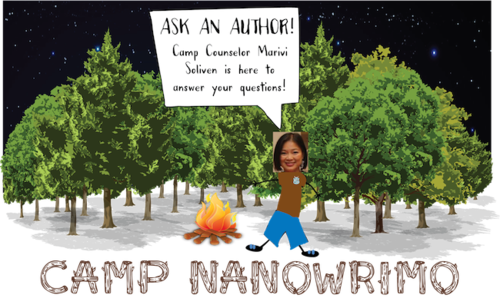
Each week, a new author will serve as your Camp Counselor, answering your writing questions. Marivi Soliven, our second counselor, has taught writing workshops at the University of California, San Diego and at the University of the Philippines. Her most recent novel, The Mango Bride, is about two Filipina women, and the unexpected collision that reveals a life changing secret.
How do you write dialogue that drives the plot versus distracts from it? — coffeeshoptuesdays
I use dialogue as a way to fill out the personalities of my characters. In The Mango Bride, all the characters speak English; each one does so in different registers to better illustrate each one’s social class, which is a pivotal factor in the primary characters’ destiny.
For example, Señora Concha’s speech is peppered with Spanish phrases and cuss words. The ability to speak Spanish is considered by some Filipinos as a sign of a good family, better education, and social prestige, all of which Señora Concha loves to flaunt.
Using dialogue in this way moves the plot forward because readers begin to understand how a character thinks and sounds, and why she makes certain choices in the course of the story. Good dialogue brings a character alive in the reader’s mind.
Dialogue also moves a plot forward if it reveals a new twist in the story, or implies that there is a secret waiting to be revealed. I use this quite a bit in the beginning of the novel, where Amparo keeps trying to find out what scandal estranged her Uncle Aldo from the Guerrero clan. The dialogue in those scenes sound like the two are circling each other in a verbal dance—the Uncle speaks in double entendre the entire time. The secret is revealed toward the end of the novel, during a violent fight… and in a crucial piece of dialogue.
Next week’s Camp Counselor will be Patricia Wrede, author of fantasy novels such as the The Enchanted Forest Chronicles.
April 12, 2014
The NaNoWriMo Writing Marathon Is Here!
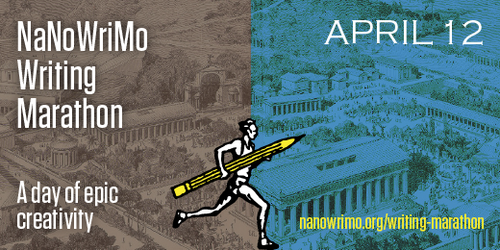
The NaNoWriMo Writing Marathon is here! We’ll be word-sprinting away from 9:00 AM to 5:00 PM PDT, Saturday, April 12. It’s just like running a marathon if you subtract the running, add writing, and keep the fun (…and probably the sweat).
How can you participate? We’ve got your agenda right here:
You can pledge your commitment to your novel.
Pledge a $13.10 donation for every hour you plan to write with us and get your official marathoner badge! All pledges will also our nonprofit programs.
The first 60 people who pledge for 3 hours or more will receive a vintage “NaNoWriMo Running Man” sticker. Plus, anyone who pledges at least $13.10 could win one of our three grand prizes:
An artfully rendered poster of your novel—with all 50,000 words—from Litographs.
NaNoWriMo VIP status that gets you all of our latest merchandise before it hits stores, access to all NaNoWriMo webinars, and a Viking helmet!
Your novel’s cover designed by a BiblioCrunch graphic designer of your choice.
You can fuel up on inspiration with us on Twitter.
Use the hashtag #NaNoThon to join our all-day tweet-a-thon to keep you and your novel motoring to the finish line!
You can word-sprint during our live streams on YouTube.
Get ready for eight sessions of live-streaming goodness during the eight-hour marathon. Last year, there were writing prompts, literary teas, puppet shows, songs, and very little sense:
Hour 1 with Director of Programs Chris Angotti, s’mores expert
Hour 2 with Editorial Director Tim Kim, campfire singer
Hour 3 with Office Captain Shelby Gibbs, tea brewer extraordinaire
Hour 4 with Executive Director Grant Faulkner, with bonus adorable children
Hour 5 with former intern Lauren Harsma, Head Girl
Hour 6 with Volunteer Coordinator Paige Knorr, Canadian
Hour 7 with Deputy Director Tavia Stewart-Streit, human dare machine
Hour 8 with the return of Shelby Gibbs
Hour 9: The Wrap-Up with an encore performance from Chris Angotti
Training with daily word sprints, and taking this very good excuse to carb-load,
Tim, Editorial Director
April 11, 2014
Ask An Author: "How can you be sure that your plot is actually compelling, and not just a pile of stuff that happens?"

Each week, a new author will serve as your Camp Counselor, answering your writing questions. Marivi Soliven, our second counselor, has taught writing workshops at the University of California, San Diego and at the University of the Philippines. Her most recent novel, The Mango Bride, is about two Filipina women, and the unexpected collision that reveals a life changing secret:
How can you be sure that your plot is actually compelling, and not just a pile of stuff that happens? — The Freelancer Society
Novelist Drusilla Campbell answers this question by comparing a novel and its parts to weaving cloth on a loom. Imagine your plot is a red weft—the thread that runs crosswise through that cloth. The events are all the vertical threads, called the warp, that your weft runs across. A compelling plot is a weft that intersects all the warps from one end of that cloth to the other: from the inciting incident that gets your novel on its way, to the many detours and adventures your protagonists take, all the way to the very last scene.
If you build your plot correctly so that characters are reacting to events, even surprising scenes become logical.
At the end of the novel, you should be able to tug on that red thread and see each of the preceding scenes “pull” along with it. If that happens, chances are you’ve composed a compelling plot. If you pull and nothing happens, you’ll probably need to tighten or delete the irrelevant scenes.
Additionally, I like to construct an “internal logic” which defines the way your imagined world functions. Your characters move according to the rules you create so that their actions become logical or plausible to someone reading your story. When your story’s internal logic is strong, it enables readers to suspend their belief and go along for the ride, because what happens makes sense. Thus Bram Stoker’s vampire perishes in the sunlight, because that’s how his novel’s internal logic works. On the other hand, according to Stephanie Meyer’s internal logic, it makes it possible for her Twilight vampires to survive in the watery sunlight of the Pacific Northwest.
Next week’s Camp Counselor will be Patricia Wrede, author of fantasy novels such as the The Enchanted Forest Chronicles.
April 10, 2014
"Listen beyond the rustling leaves of the tree shading you, and...

"Listen beyond the rustling leaves of the tree shading you, and the chirps of birds outside your cabin. Hear your novel calling you from the woods. Follow the sound of its voice. It wants you to trudge on, exploring uncharted territory. Listen, follow, and push."
Alicia Audrey Wallace, on creating a relationship with your writing.
Photo by Flickr user GabPRR.
Chris Baty's Blog
- Chris Baty's profile
- 63 followers



